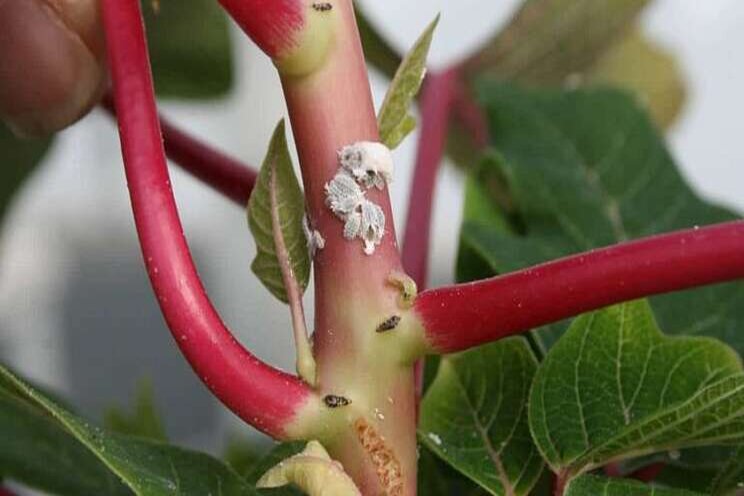Tips on mealybugs
Added on 27 April 2021

Answer: The question you ask is very appropriate and timely. In general, the common mealybug species encountered in greenhouse production systems is the citrus mealybug, Planococcus citri.
Citrus mealybugs use their piercing-sucking mouthparts to withdraw plant fluids from the vascular tissues or phloem sieve tubes. During feeding, citrus mealybugs excrete honeydew, a clear, sticky liquid that serves as a substrate for black sooty mold.

Mealybugs feeding on plant stem.
Citrus mealybug can disperse among greenhouse-grown horticultural crops when plant foliage is touching. One adult female citrus mealybug can lay over 400 eggs during her lifetime. Therefore, managing citrus mealybugs by killing the nymphs (crawlers) before they develop into adults (males and females) is important.
Insecticides are primarily used to suppress citrus mealybug populations in greenhouse production systems. So, why are citrus mealybugs so difficult to manage with insecticides? First, in our research at Kansas State University, we have found that systemic insecticides applied to the growing medium as a drench or granule are not effective (i.e., based on the level of mortality), in suppressing citrus mealybug populations under greenhouse conditions to prevent plant damage. Therefore, spray applications of contact insecticides are required. However, contact insecticides may have limited effectiveness against citrus mealybugs due to the following:
- The later instars and adults have a hydrophobic (water-repelling) waxy covering that protects citrus mealybugs from exposure to insecticide spray residues.
- There may be difficulty in obtaining thorough coverage with insecticide spray applications of all above-ground plant parts (leaves and stems) where citrus mealybugs feed, especially on large plants.
- Citrus mealybugs reside in protected or hidden areas on plants that can reduce exposure of individuals (nymphs and adults) to insecticide spray applications.
- Overlapping generations with an age structure that consists of all life stages (eggs, nymphs and adults), can be present simultaneously.
Contact insecticides are most effective against the early-instar nymphs because they do not have a hydrophobic waxy covering. However, applying sufficient spray volumes to obtain thorough coverage of all plant parts including: the underside and upper side of leaves, stems, and applying contact insecticides frequently, are essential in managing citrus mealybug populations.
In our research, we have found that spray applications of acetamiprid (TriStar) to be most effective against the citrus mealybug. Nonetheless, high-volume sprays and repeat applications are necessary. Furthermore, based on our research, the addition of a surfactant to an insecticide solution may not enhance the efficacy of the spray application.
A major problem associated with using contact insecticides to suppress citrus mealybug populations is that high mortality (>90%) is required. The reason is that if just one adult female escapes exposure from insecticide spray applications then the female will lay her compliment of eggs (oviposit), which will lead to 300 to 600 nymphs emerging (eclosing) from the eggs and subsequently feeding on a plant.
In general, if a plant is 50% infested with citrus mealybugs, which will depend on plant size, then the plant should be disposed of immediately. Therefore, it is important to scout crops at least twice per week, especially those susceptible to citrus mealybug, to detect infestations early enough so that insecticides can be applied accordingly.
For more information on how to manage citrus mealybugs in greenhouse production systems, consult the following extension publication: Mealybug: Management in Greenhouses and Nurseries (https://bookstore.ksre.ksu.edu/pubs/mf3001.pdf).
Source and Photo Courtesy of Greenhouse Product News
Source: Greenhouse Product News
More news















